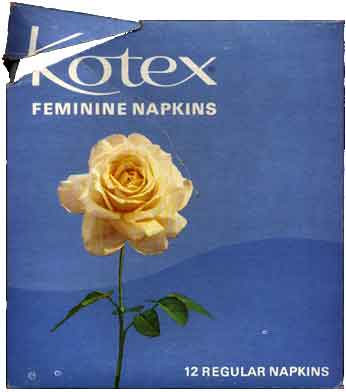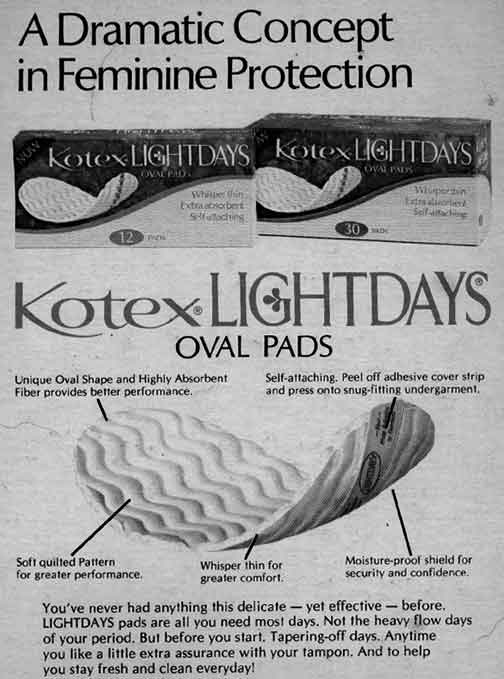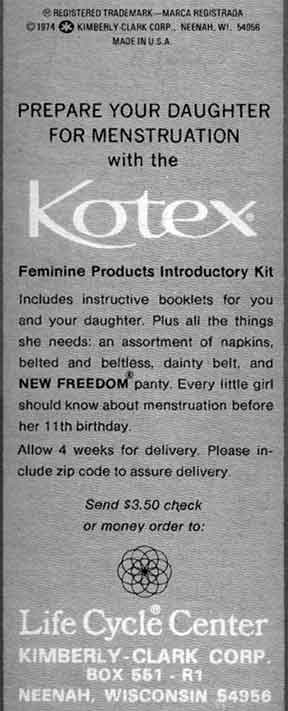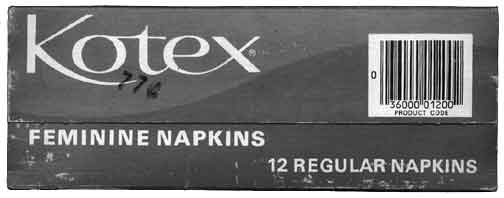See more Kotex items: First ad (1921;
scroll to bottom of page) - ad 1928 (Sears and Roebuck catalog)
- Lee Miller ads
(first real person in a menstrual hygiene ad,
1928) - Marjorie May's
Twelfth Birthday (booklet for girls, 1928,
Australian edition; there are many links here to
Kotex items) - Preparing
for Womanhood (1920s, booklet for girls;
Australian edition) - 1920s booklet in Spanish
showing disposal
method - box
from about 1969 - "Are you in the know?"
ads (Kotex) (1949)(1953)(1964)(booklet, 1956) - See
more ads on the Ads for
Teenagers main page


|

Kotex box and menstrual pad,
copyrighted 1974 (U.S.A.)
Box, below
|
This pad was designed for a belt,
although self-adhesive pads had
already appeared (for example, Kotex's
New Freedom).
Some women preferred the older style
pads, and women used these after
bearing a child; they absorbed the
escaping fluid and material from the
vagina. Only in 2001 did Kotex stop
making them.
The rose is now yellow, in contrast
to the white one of the late 1950s and
1960s. Manufacturers often associate
flowers with menstruation, evoking
"femininity," a nice smell (replacing
the out-of-favor odor of menses), and
the word flowers,
an old one meaning menstruation - but
almost no one would know that today.
(See a cup-shaped
tulip advertising a menstrual
cup.)
As I wrote on the page for the 1960s Kotex,
most American woman want to wind up smelling like a rose,
not menstrual blood! But at least at
times in the past - and maybe today in
places - women
allowed others to smell and see her
menstrual blood as a sign of
fertility and to sexually attract
others, as extraordinary this
may seem to most North Americans and
Europeans (and to me just a couple of
years ago). (The English feminist
Selina Cooper writes
(towards the bottom of the page)
about this among English girls in a
cotton mill around 1900, where straw covered the
floor to absorb their escaping blood.)
This
fact lends credence to my suspicion
that many or most women in Europe and
North America prior to about 1900 bled into their
clothing - that is, they did
not use rags or tampons or anything
else to absorb and conceal the blood.
Times sure have changed - why? Read more about
this.
|
|

Front of box. The box
measures 8" x 7.35" x 2.75" (about
20.6 x 18.6 x 7 cm).
|
|

Back of box (only the
part containing text)
|
|
 
Sides of box, reduced
to show only text.
At right: Kotex had pioneered the
explanatory booklets for girls (see a
cover from 1948)
- and also for women
- produced by pad companies.
At left:
Kotex had sold tampons since the 1930s
(for example, Fibs
- and see roughly contemporary ads for Kotex
stick tampons and a later stick
tampon).
|
|

Bottom of box, full
area
|
See the pad. See a Kotex pad
probably from the 1930s
and one from the early
1960s.
© 2001 Harry Finley. It is
illegal to reproduce or distribute any of the
work on this Web site in any manner or medium
without written permission
of the author. Please report suspected
violations to hfinley@mum.org
|







